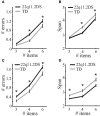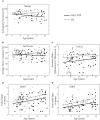The development of cognitive control in children with chromosome 22q11.2 deletion syndrome
- PMID: 24959159
- PMCID: PMC4050531
- DOI: 10.3389/fpsyg.2014.00566
The development of cognitive control in children with chromosome 22q11.2 deletion syndrome
Abstract
Chromosome 22q11.2 Deletion Syndrome (22q11.2DS) is caused by the most common human microdeletion, and it is associated with cognitive impairments across many domains. While impairments in cognitive control have been described in children with 22q11.2DS, the nature and development of these impairments are not clear. Children with 22q11.2DS and typically developing children (TD) were tested on four well-validated tasks aimed at measuring specific foundational components of cognitive control: response inhibition, cognitive flexibility, and working memory. Molecular assays were also conducted in order to examine genotype of catechol-O-methyltransferase (COMT), a gene located within the deleted region in 22q11.2DS and hypothesized to play a role in cognitive control. Mixed model regression analyses were used to examine group differences, as well as age-related effects on cognitive control component processes in a cross-sectional analysis. Regression models with COMT genotype were also conducted in order to examine potential effects of the different variants of the gene. Response inhibition, cognitive flexibility, and working memory were impaired in children with 22q11.2DS relative to TD children, even after accounting for global intellectual functioning (as measured by full-scale IQ). When compared with TD individuals, children with 22q11.2DS demonstrated atypical age-related patterns of response inhibition and cognitive flexibility. Both groups demonstrated typical age-related associations with working memory. The results of this cross-sectional analysis suggest a specific aberration in the development of systems mediating response inhibition in a sub-set of children with 22q11.2DS. It will be important to follow up with longitudinal analyses to directly examine these developmental trajectories, and correlate neurocognitive variables with clinical and adaptive outcome measures.
Keywords: 22q11.2 deletion syndrome; catechol-O-methyltransferase (COMT); childhood cognitive development; cognitive control; developmental disorders; executive function.
Figures







References
-
- Angkustsiri K., Leckliter I., Tartaglia N., Beaton E. A., Enriquez J., Simon T. J. (2012). An examination of the relationship of anxiety and intelligence to adaptive functioning in children with chromosome 22q11.2 deletion syndrome. J. Dev. Behav. Pediatr. 33, 713–720 10.1097/DBP.0b013e318272dd24 - DOI - PMC - PubMed
Grants and funding
LinkOut - more resources
Full Text Sources
Other Literature Sources
Miscellaneous

